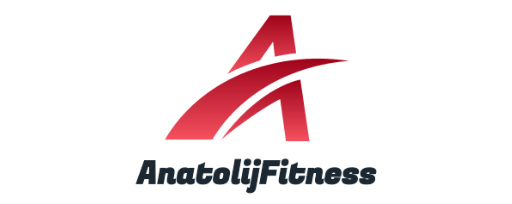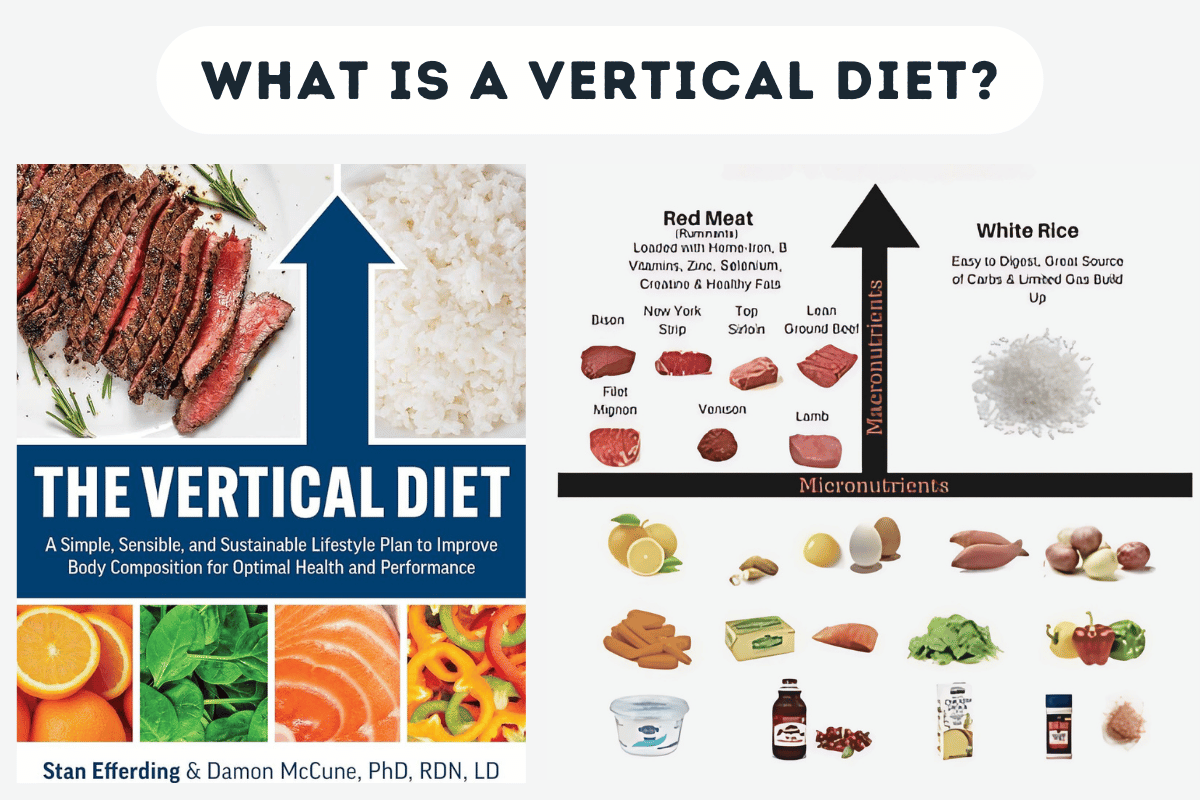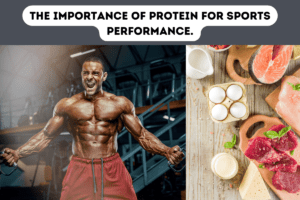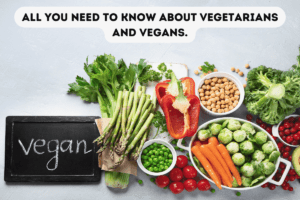The Vertical diet is a performance-based diet designed specifically for athletes. It was developed by a professional bodybuilder and powerlifter Stan Efferding to help sport people reach their goals in muscle gains and weight loss. A vertical diet is called Vertical because it looks like an upside-down T. Underneath, at the bottom you have products that provide you with critical micronutrients (vitamins and minerals). At the top are two foods: red meat and white rice, which should provide you with all the macronutrients you need (Carbs, protein, and fat) to get enough calories for your training. In this article we will speak about the main goals of a vertical diet, what food you should eat or avoid, how you can improve your digestion, and in the end, we will discuss benefits and drawbacks of Vertical Diet so that you could decide is it good for you to follow or not. Now, let’s start with the main goals of a Vertical Diet.
What are the main goals of a Vertical diet?
The first goal of a Vertical diet is to get the necessary number of calories. Some athletes may need 8000 kcal/day to keep their muscle mass. These calories should come from foods that are easy to digest and don’t give you digestive issues. There are no calories in micronutrients (vitamins and minerals), just in macronutrients (protein, carbs, and fat). According to Stan Efferding, the best carbohydrate to get enough calories and don’t create digestive issues is white rice. The best source of protein is red meat. Important to understand that the Vertical diet is selective and not restrictive so that you can choose other sources of carbs, protein, and fat (we will speak about these later in the article). But according to Stan Efferding, white rice and red meat are the best sources of macronutrients to get enough calories.
The second goal of a Vertical diet is to get all the necessary micronutrients. All micronutrients like vitamins and minerals are required in small quantities for our body for a number of different functions. Without sufficient vitamins and minerals, many metabolic pathways could fail to function correctly, causing ill health and even death. That’s why getting all of them from your diet is very important. You can read more about the importance and functions of all micronutrients in my article: “The basics of vitamins and minerals in your diet, and why are they so important?”.
The third goal of a vertical diet is to improve digestion. As I told you before, some athletes may need 8000kcal/ day to maintain their muscle mass or performance. And some foods in big quantities can affect your digestive system. Just imagine how difficult it would be to eat such a big amount of food each day and always feel bloating or other digestive issues. That’s why Stan Efferding is speaking a lot about FODMAPS. But more about these later in the article.
Also, the Vertical diet includes suggestions on training and recovery protocols. Because if you want to lose weight, gain muscle mass, or improve your physical performance, you need not just diet, you need to exercise and recover properly as well. That’s why this diet is so unique for me. Of course, there can be some minuses to such a diet, and we will also speak about them. But all in all, it is worth of trying. This article will discuss just the basics of a Vertical diet. If you want to know how to gain, lose weight, exercise, and recover according to the Vertical diet, you can read my article: “How to eat, train and recover according to a Vertical diet“.
What to eat and what to avoid on a Vertical diet?
The Vertical Diet is composed of a variety of highly bioavailable, nutrient-dense foods that will provide you with all necessary for your body macro and micronutrients. Diet is selective, not restrictive, which means if you don’t like some of the foods listed in the diet, you can change them, ideally with food with a similar nutrient profile. The list of foods to eat is showed below.
| Food to eat | Benefits |
| Lean red meat: beef, bison, goat, lamb, venison | The meat of a ruminant animals is a good source of protein, is very bioavailable and contains micronutrients like heme iron, B vitamins, zinc, and selenium. If you don’t like red meat, you can change it with chicken and turkey. It also will be a good source of protein, but red meat is a better source of micronutrients. |
| Fatty fish (salmon, trout, sardines) | Good source of protein and omega 3 fatty-acids. Also contains potassium. |
| Eggs | Whole eggs and egg yolks contain vitamin K2, biotin, B vitamins and choline. Eggs are highly nutritious and are linked to a reduced risk of heart disease and stroke as well as improved eye health. |
| Dairy | Such products like yoghurt, milk and cheese contains lots of calcium, vitamin D and phosphorus, which helps to build strong bones, promotes the growth and maintenance of muscle tissue. Yogurt and kefir also contain plenty of probiotics for better digestive health. Milk contains lactose and if your body don’t tolerate lactose, better choose hard cheese like cheddar and Greek yoghurt. |
| Chicken stock/Bone broth | Helps to improve digestion. |
| Butter | Butter is high in calories and should be used in moderation, but it is a great source of vitamin A and vitamin E. |
| White rice | Great source of extra calories if you are on a weight gain program, easy to digest. Sprinkling rice with little bit of dextrose can make it easier to consume in greater quantities. Also, eat freshly prepared rice to prevent the formation of indigestible resistant starch. |
| Potatoes | Potatoes are rich in potassium which helps to regulate fluid balance, promotes proper nerve function, and protects against stroke and kidney stones. Potatoes are easy to digest, and they give feeling of satiety. Also, potatoes contain vitamins C, B, and fiber. |
| Soaked and fermented oats and legumes | Oatmeal and legumes have lots of micronutrients, but they can be difficult to digest and absorb in large quantities (because of antinutrients in them). For this reason, they should be soaked or fermented before consuming. As to oats, to make it simpler, you can purchase quick oats or instant oatmeal, which was already been broken down a little bit during processing. |
| Nuts | In a Vertical diet Stan Efferding suggests eating almond nuts, but before consuming they also must be soaked or fermented. Almonds has ton of nutrients like magnesium, vitamin E, and plenty of healthy fat. But they contain phytic acid as well, which can bind with important minerals like zinc, calcium, iron, magnesium and inhibit their absorption. |
| Sourdough bread | Bread is a wheat product which contains antinutrients like phytic acid and gluten. That’s why it is not recommended on a Vertical diet. Sourdough bread is little bit different because contains prebiotics for improved gut health. Sourdough is rich in iron, B vitamins and selenium. It also contains gluten and phytic acid but better for digestion than normal bread. |
| Fruits and juices | On a Vertical diet all fruits are allowed. As to juices, Stan Efferding recommends orange juice for vitamin C, potassium, and fructose to stimulate metabolism and liver function. Also recommends cranberry juice which has plenty of iodine to optimize thyroid function, boost metabolism, improve immunity and digestion. Cranberry juice should be natural, not from concentrate. |
| Low-FODMAP vegetables | The most important, all vegetables should be low-FODMAP. Especially Stan Efferding recommends bell peppers, carrots, and spinach. Bell peppers have vitamins C, E, A, B6 and potassium which is important for blood and bone health. They are FODMAP foods, full of nutrients and easy on digestion. Carrots contain vitamin A, beta carotene and antioxidants. Also, they are full of fiber. It is recommended to eat them raw. Spinach has such nutrients like potassium, magnesium, and folic acid. Also, it is a good source of iron, calcium, and antioxidants. The only problem, it also contains antinutrients (oxalates) which can contribute to kidney stones. Cooking spinach can reduce its oxalate concentration. |
| Sodium | According to Vertical diet, you must salt all your meals to taste, especially pre and post workout. Especially if you are an athlete, you need more sodium than average person. And it is better to use iodized salt to improve digestion, metabolism, and performance. |
| Food to avoid | Drawbacks |
| Grains and legumes | As mentioned before, they can be difficult to digest and absorb in large quantities because of antinutrients in them. For this reason, they should be soaked or fermented before consuming. |
| Highly processed vegetable oils (canola oil, soybean, sunflower and other oils) | These oils are chemically processed using heat, pressure and industrial solvents that alter their chemical makeup. They have a low smoke point and are extremely harmful to your body. |
| High-FODMAP vegetables | Such vegetables like cauliflower, broccoli, asparagus, garlic, and onion. These vegetables have some antinutrients in them that can create gas, bloating, impaired thyroid function. |
| Sugar alcohols: erythritol, xylitol, sorbitol, etc. | Sugar alcohol sweeteners are sugar substitutes. They are much lower in calories and can help you lose some weight if you use them instead of sugar but the problem with them, they can give you gas, bloating and diarrhea. Sugar alcohols can be found naturally in some fruits such as apples, avocados, cherries, pineapple and watermelon, and overconsumption can cause bloating, if you are sensitive. But the biggest amount of them can be found in processed foods like sugar-free and reduced-sugar baked goods, desserts, candy, and other sweet treats. Also, sugar alcohols are in protein powder, pre-workout drink, and protein bars. |
| Added sugar | Too much sugar is always bad on any diet. It can give you problems from tooth decay to diabetes, so try to minimize amount of sugar in your diet. |
| Coffee and alkalized water | Part of success with Vertical diet is associated with proper amount of digestive fluid in your stomach and enough acidity to properly digest food. If your stomach is not acidic enough, you won’t be able to properly digest your food or absorb nutrients, and you could experience abdominal discomfort. For this reason, you should avoid drinking too much water during your meals, especially alkalized water, which dilutes stomach acid and raises its ph. Also, you should reduce your coffee intake because it can cause acid reflux by relaxing the lower esophagus sphincter, impairing its ability to close against acid. |
Short overview.
Now, looking at everything above, let’s make a short overview. The Vertical Diet has three main goals. The first goal is to get enough calories from your diet. It is essential if you are trying to lose or gain weight. If your goal is weight loss – you need a calorie deficit. If your goal is weight gain – you need a calorie surplus. Some athletes may need 8000 kcal and even more to maintain their muscle mass and for performance. We are getting calories just from macronutrients (protein, fat, and carbohydrates). The second goal of a Vertical diet is to get all the necessary micronutrients for the body (vitamins and minerals). Goal three is to improve digestion because the Vertical diet focuses primarily on athletes who need to eat lots of calories.
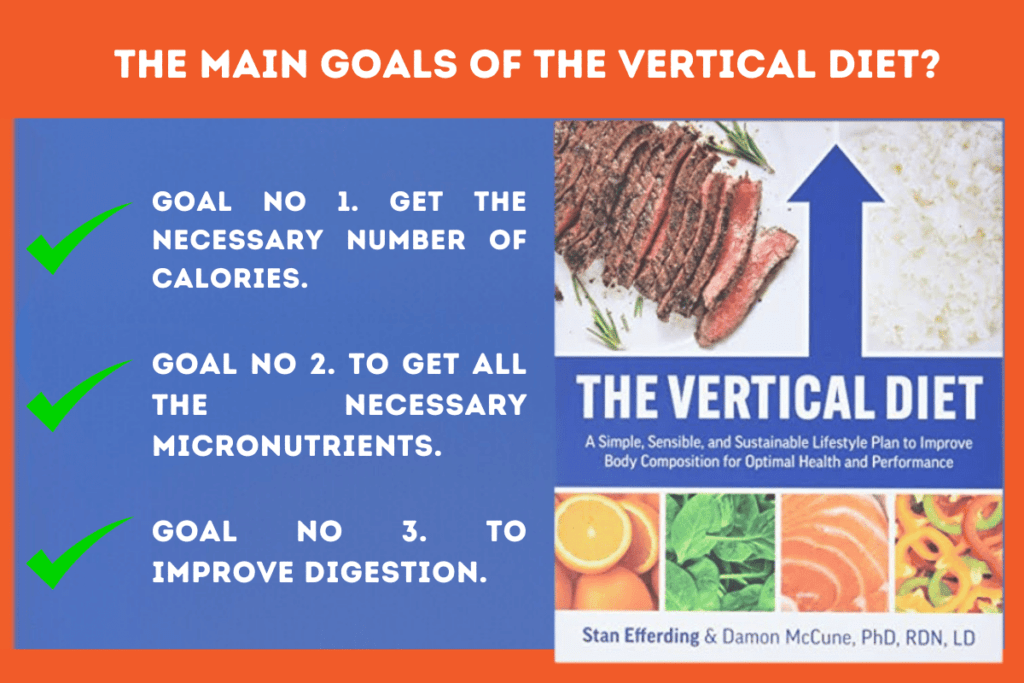
Regarding macronutrients, the primary protein sources on a Vertical Diet are red meat, salmon, and eggs. Dairy is a good source of protein as well if you can tolerate lactose. If your body doesn’t tolerate lactose, you can use hard cheese like Cheddar or Greek yoghurt, which contains less lactose. The Vertical Diet is selective and not restrictive. This means that instead of red meat, you can also use chicken, although it is less nutrient-rich than red meat. If you worry about saturated fat and cholesterol, read my article about red meat: “Why red meat is not so bad for you?“. According to the Vertical Diet, red meat is a more efficient protein source than plant-based proteins. For example, to get the same amount of protein as a 3-ounce serving of lean beef, you would have to consume more than 3 cups of quinoa (more than 650 calories), and your body would still not be able to absorb nearly as much of it because humans do not properly digest cellulose.
The next macronutrient would be fat. Dietary fat is a source of fat-soluble vitamins (A, D, E, K) and is necessary to maintain good health and hormonal balance. A Vertical Diet suggests getting most of your fat from animal protein sources such as red meat, fish, dairy and eggs. A vertical diet doesn’t prioritize getting fat from sources like avocados and nuts because they can cause gas and bloating in some people. Just try to keep your saturated fat to less than 10% of your total daily calories. Use butter, ghee, beef fat, or cold-pressed oils like avocado, coconut, and extra virgin olive oil for cooking fats. Don’t use processed vegetable oils.
As to carbs, we do not exclude them from a vertical diet. Carbs are the primary source of energy in the body. Our brain runs exclusively on glucose. Eating not enough carbohydrates can slow your metabolism and affect your weight loss, and not enough carbohydrates will affect your sports performance badly. The Vertical Diet suggests eating micronutrient-dense (potassium-rich), easy-to-digest carbohydrates like potatoes, fruits, spinach, carrots and other low-FODMAP foods. A Vertical Diet recommends eating more white rice for athletes who need significantly more calories (for example, 8000 kcal/day). According to diet, white rice is easier to digest than carbs like pasta, oatmeal, and some vegetables, and brown rice rises in large quantities. Again, in a small quantity oatmeal will be ok for digestion, but it can create digestive issues in large quantities. That’s why the Vertical Diet suggests white rice more.
All foods listed above will give you all the vitamins and minerals you need for your body. Food listed vertically (red meat and white rice) is the main food from where you are getting most of your calories. You also get micronutrients from red meat like heme iron, B vitamins, zinc, and selenium. Other remaining micronutrients you are getting from foods listed horizontally (oranges, soaked almond nuts, eggs, potatoes, carrots, butter, oily fish, spinach, peppers, Greek yoghurt, cranberry juice, chicken stock and salt). Diet is selective, not restrictive, which means if you don’t like some of the foods listed in the diet, you can change them, ideally with food with a similar nutrient profile.
The third goal of the Vertical Diet is to improve digestion. You can do it by drinking a tablespoon of apple cider vinegar with a few ounces of water before meals, salting all your meals, avoiding sugar, sugar alcohols, coffee, garlic and other high-FODMAP foods that cause gas, bloating. Also, getting plenty of iodine, eating more animal protein and using chicken stock with your meals will improve your digestion as well.
It is important to say that you shouldn’t restrict all foods that are not recommended on a Vertical Diet. The main goal is to improve digestion. Some people are just sensitive to different antinutrients in plants. For them, eating bread, pasta, and other high-FODMAP foods can cause gas, bloating and other digestive issues. For others, small quantities of such foods will be ok. Here, you should decide for yourself: is it ok for you to drink milk, for example, or if you have lactose intolerance, it is better to exclude this product. You can read more about FODMAP foods and different antinutrients in my article: “What is a FODMAP diet?”.
Conclusion – Benefits and drawbacks of a vertical diet.
All in all, the Vertical Diet is about eating nutrient-dense foods that are easily digestible to help you lose or gain weight, maximize workouts, and achieve better nutrient absorption. This diet could help you gain muscles, lose weight, improve sports performance, and improve gut health. It is easy to follow, and you do not restrict yourself from many foods like in other diets. It can really help you achieve your sports goals.
Some critics can say that on a Vertical diet, you are restricting yourself from foods like grains and legumes, which are linked with a lower risk of colon cancer and cardiovascular disease. Cruciferous vegetables like broccoli, cauliflower, and asparagus are some of the most nutrient-dense on the planet and are linked to reduced inflammation, cell damage, and cancer risk. But if you read more inventively about Vertical Diet, it just saying that these foods can create digestive issues in some people who has food intolerance for them. If you don’t feel digestive issues by consuming these foods, you can eat them in small quantities and better soaked or fermented. The Vertical Diet is selective and not restrictive.
Another issue can be with red meat. In lots of literature red meat is associated with colon cancer and heart diseases. However, recent research tells us that red meat is not an enemy for us and can even benefit our health. All you need is just good quality meat and proper cooking methods. Plus, if you don’t like eating red meat (it is also quite expensive) on a Vertical Diet, just change it to chicken.
The vertical diet can be more difficult for vegans. People on a vegan diet should consume a high-quality protein supplement like soy isolate, pea protein, or rice protein powder. Grains and legumes should be soaked or fermented before consuming them. To get enough omega 3, vegans should eat plenty of avocados, chia seeds, flax seeds, and walnuts. Regarding carbs, vegans should get their calories from fruits, potatoes, white rice, and low-FODMAP vegetables. More about vegetarians and vegans, I wrote in my article: “All you need to know about vegetarians and vegans”.
All in all, I see lots of benefits of the Vertical Diet. It helps me lose weight, gain muscles, improve digestive health, and also includes training and recovery protocols like no other diet. There can be some minuses of the Vertical Diet, but I definitely suggest you try it. For more about how to eat, train, and recover according to the Vertical diet, read my other article: “How to eat, train, and recover according to the Vertical diet.”
